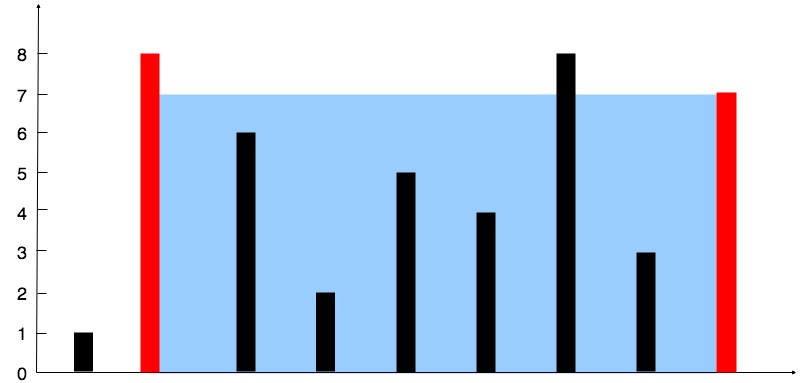Container With Most Water和3Sum
〇、11. Container With Most Water 描述
Given n non-negative integers a1, a2, ..., an , where each represents a point at coordinate (i, ai). n vertical lines are drawn such that the two endpoints of line i is at (i, ai) and (i, 0). Find two lines, which together with x-axis forms a container, such that the container contains the most water.
Note: You may not slant the container and n is at least 2.
大意:给了你柱子的高度,你得找出哪两根柱子之间的面积最大

11. Container With Most Water 思路
1、暴力解:O(n²)的方法,每根柱子和其他的匹配,遍历完毕,找到最大。
2、两头逼近:
既然是求最大面积,我们当然想高尽量大、宽也尽量大。
从上图可以看出,依次找出两根最高、最高的与次高.....最终也会变成O(n²)的方法;
所以我们从'宽'入手,首先找距离最远的两根(即下标为0,和下标最后),选择矮的柱子为高,计算并记录面积;
然后两根柱子中,我们保留高的那一根,矮的一边则向中间逼近,直到两柱子相遇...并在此过程中比较得出最大值;
在选择最远距离->宽尽量大,保留高的一方->高尽量大。
1 class Solution(object): 2 def maxArea(self, height): 3 length = len(height) 4 i = 0 5 j = length-1 6 max = 0 7 while i<j : 8 if height[i]>height[j] : 9 max = height[j]*(j-i) if max<height[j]*(j-i) else max 10 j -=1 11 else: 12 max = height[i] * (j - i) if max < height[i] * (j - i) else max 13 i += 1 14 return max
一、15. 3Sum 描述
Given an array nums of n integers, are there elements a, b, c in nums such that a + b + c = 0? Find all unique triplets in the array which gives the sum of zero.
Notice that the solution set must not contain duplicate triplets.
example: Input: nums = [-1,0,1,2,-1,-4] Output: [[-1,-1,2],[-1,0,1]]
大意:给出一连串的整数,找出其中加起来等于0的三个元素(可能有0组或多组,且不能重复)
15. 3Sum 思路
我们可以固定一个元素,然后找其它两个元素,即 -a = b + c,这样就可以和11. Container With Most Water 差不多,采用两头(i,j)逼近方法。
但困难的地方在于 不能重复(像例子中,虽然有两个-1,但结果不能有两个[-1, 0, 1],要保证组与组的数值不能完全同样);
解决办法是跳过 已经判断的、重复的 元素;
小细节:三个元素和为0,所以其中要么正负搭配,要么全为0,可以将数组先排序,到固定位为正数时,迭代便可停止。

1 class Solution(object): 2 3 def threeSum(self, nums): 4 nums.sort() 5 result = [] 6 for start in range(len(nums)): 7 8 if start > 0 and nums[start] == nums[start-1]: # 跳过重复的固定位 9 continue 10 11 i = start+1 12 j = len(nums)-1 13 oneSum = -nums[start] 14 15 while i < j and nums[start] <= 0: 16 twoSum = nums[i] + nums[j] 17 if twoSum > oneSum: 18 j -= 1 19 elif twoSum < oneSum: 20 i += 1 21 else: 22 temp = [nums[start], nums[i], nums[j]] 23 result.append(temp) 24 while i < j and nums[i] == nums[i+1]: # 跳过重复的,已判断的i 25 i += 1 26 while i < j and nums[j] == nums[j-1]: # 跳过重复的,已判断的j 27 j -= 1 28 i += 1 29 j -= 1 30 return result





